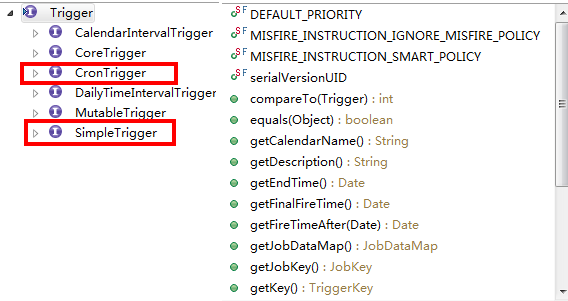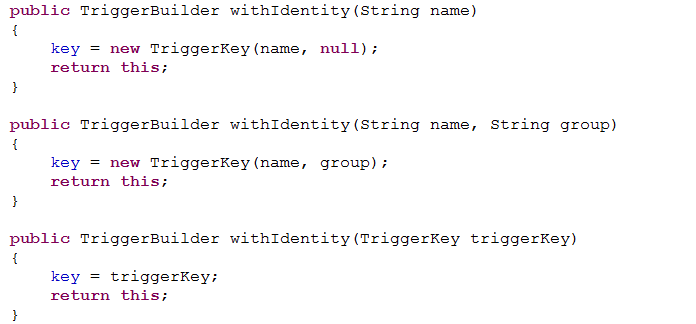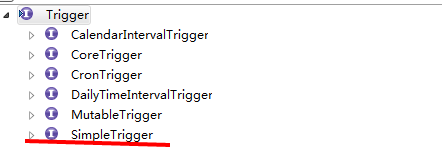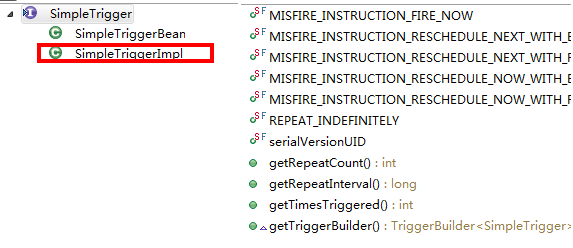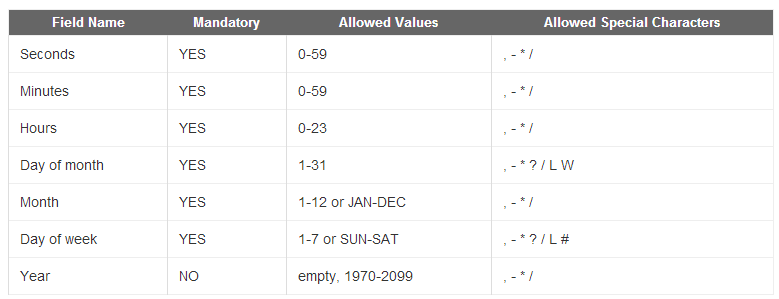【原创】Quartz代码详解
阅读目录
- 简单介绍
- 章节1:Quartz简单实例
- 章节2:Job、JobDetail、JobBuilder
- 章节3:Trigger、TriggerBuilder
- 章节4:Scheduler
- 章节5:JobListener、SchedulerListener、TriggerListener
- 章节6:Cron表达式
- 章节7:参考链接
简单介绍
- Scheduler:调度器,将Job和Trigger关联起来;
- Job :需要执行的作业;
- Trigger :触发器,指定执行的时间,主要包括两种方式:
一、Quartz简单实例
SchedulerFactory schedFact = new org.quartz.impl.StdSchedulerFactory();
Scheduler sched = schedFact.getScheduler();
sched.start();
// define the job and tie it to our HelloJob class
JobDetail job = newJob(HelloJob.class)
.withIdentity("myJob", "group1")
.build();
// Trigger the job to run now, and then every 40 seconds
trigger = newTrigger()
.withIdentity("myTrigger", "group1")
.startNow()
.withSchedule(simpleSchedule()
.withIntervalInSeconds(40)
.repeatForever())
.build();
// Tell quartz to schedule the job using our trigger
sched.scheduleJob(job, trigger);
二、Job、JobDetail、JobBuilder
- Job - an interface to be implemented by components that you wish to have executed by the scheduler.
- JobDetail - used to define instances of Jobs.
- JobBuilder - used to define/build JobDetail instances, which define instances of Jobs.
Job
public class HelloJob implements Job {
public HelloJob() {
}
public void execute(JobExecutionContext context)
throws JobExecutionException
{
System.err.println("Hello! HelloJob is executing.");
}
}
JobDetail
JobDetail job = newJob(HelloJob.class)
.withIdentity("myJob", "group1") // name "myJob", group "group1"
.build();
//带参数
JobDetail job = JobBuilder.newJob(clazz)
.withIdentity(new JobKey(jobName, groupName))
.usingJobData(new JobDataMap(params))
.build();
- key;
- JobClass;
- JobDataMap;等
JobBuilder
三、Trigger、TriggerBuilder
SimpleTrigger
CronTrigger
TriggerBuilder
四、Scheduler
Scheduler scheduler = StdSchedulerFactory.getDefaultScheduler();scheduler.start();scheduler.shutdown();
* ("all values") - used to select all values within a field. For example, "" in the minute field means *"every minute".
? ("no specific value") - useful when you need to specify something in one of the two fields in which the character is allowed, but not the other. For example, if I want my trigger to fire on a particular day of the month (say, the 10th), but don't care what day of the week that happens to be, I would put "10" in the day-of-month field, and "?" in the day-of-week field. See the examples below for clarification.
- - used to specify ranges. For example, "10-12" in the hour field means "the hours 10, 11 and 12".
, - used to specify additional values. For example, "MON,WED,FRI" in the day-of-week field means "the days Monday, Wednesday, and Friday".
/ - used to specify increments. For example, "0/15" in the seconds field means "the seconds 0, 15, 30, and 45". And "5/15" in the seconds field means "the seconds 5, 20, 35, and 50". You can also specify '/' after the '' character - in this case '' is equivalent to having '0' before the '/'. '1/3' in the day-of-month field means "fire every 3 days starting on the first day of the month".
L ("last") - has different meaning in each of the two fields in which it is allowed. For example, the value "L" in the day-of-month field means "the last day of the month" - day 31 for January, day 28 for February on non-leap years. If used in the day-of-week field by itself, it simply means "7" or "SAT". But if used in the day-of-week field after another value, it means "the last xxx day of the month" - for example "6L" means "the last friday of the month". You can also specify an offset from the last day of the month, such as "L-3" which would mean the third-to-last day of the calendar month. When using the 'L' option, it is important not to specify lists, or ranges of values, as you'll get confusing/unexpected results.
W ("weekday") - used to specify the weekday (Monday-Friday) nearest the given day. As an example, if you were to specify "15W" as the value for the day-of-month field, the meaning is: "the nearest weekday to the 15th of the month". So if the 15th is a Saturday, the trigger will fire on Friday the 14th. If the 15th is a Sunday, the trigger will fire on Monday the 16th. If the 15th is a Tuesday, then it will fire on Tuesday the 15th. However if you specify "1W" as the value for day-of-month, and the 1st is a Saturday, the trigger will fire on Monday the 3rd, as it will not 'jump' over the boundary of a month's days. The 'W' character can only be specified when the day-of-month is a single day, not a range or list of days.
The 'L' and 'W' characters can also be combined in the day-of-month field to yield 'LW', which translates to *"last weekday of the month"*.
- # - used to specify "the nth" XXX day of the month. For example, the value of "6#3" in the day-of-week field means"the third Friday of the month" (day 6 = Friday and "#3" = the 3rd one in the month). Other examples: "2#1" = the first Monday of the month and "4#5" = the fifth Wednesday of the month. Note that if you specify "#5" and there is not 5 of the given day-of-week in the month, then no firing will occur that month.
七、参考链接
附件列表
- 1.png
- 1_2.png
- 1_3.png
- 2.png
- 3.png
- a2.png












